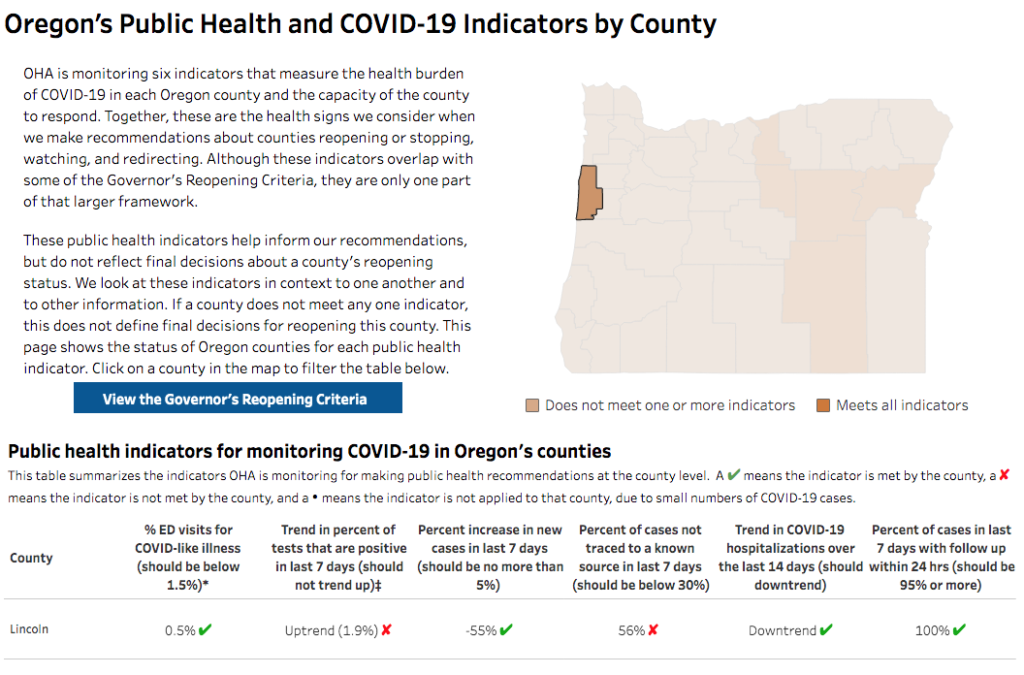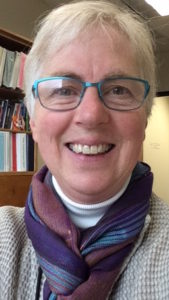
By QUINTON SMITH/YachatsNews.com
Oregon Gov. Kate Brown on Thursday took Lincoln County off a state “watch list” for uncontrolled spread of the coronavirus, saying the county had recovered from a massive outbreak at a seafood processing plant and now meets standards for knowing where and how people are contracting COVID-19.
The governor took Lincoln and Union counties off the original list of nine announced July 3 because of large, per capita increases in coronavirus cases. Both had significant outbreaks — at Pacific Seafood in Newport and at a pentecostal church near LaGrande.

“These two counties were particularly hard hit with significant outbreaks but have worked very hard to get things under control. Kudos to the public health staff and all the people involved in the response to the outbreak,” Dr. Dean Sidelinger, state epidemiologist said in a statement. “And also we should congratulate the citizens in these counties for their work to protect themselves, their families, friends, and neighbors. The collective effort and the seriousness with which the whole community took the outbreak was impressive.”
But Brown added three other counties Thursday to the list — Multnomah, Marion and Hood River — which allows them to get additional state monitoring and resources.
Lincoln County has had 385 COVID-19 cases and eight deaths since March, five of those coming in early July when five elderly and infirm residents of Avamere Rehabilitation in Newport died when the coronavirus swept through that facility.
Over the past 14 days — July 17 to Wednesday, July 30 — there have been 21 cases and no more deaths. On Friday, however, Lincoln County reported six more COVID-19 cases and its ninth death, an 81-year-old man with health issues who tested positive June 23 and died Wednesday at his residence. Lincoln County Public Health said the six new cases involved two that were acquired somewhere in the community, and four — including two presumptive cases — from close contact with a known infected person.
To get off the list, Lincoln County had to have 25 or fewer COVID-19 cases over a 14-day period that cannot be traced to a known source – called “sporadic cases.” The county meets that benchmark.
Once the county is off the governor’s “watch list” it can apply for Phase 2 reopening.
On Monday, Lincoln County commissioners indicated they would wait several weeks and for more COVID-19 case information before discussing whether to ask the state to loosen restrictions on businesses.
But commissioners were also told that with new, tighter restrictions put in place last week by the governor, there is little difference between Phase 1 and Phase 2 of the state’s reopening plan.

Lincoln County is one of four Oregon counties still in Phase 1 of the state’s three-stage reopening plan. The others are the three Portland-area jurisdictions of Multnomah, Washington and Clackamas counties.
Brown said that Lincoln County staying in Phase 1 helped it get better control over coronavirus spread.
While it met the standards for getting off the governor’s “watch list” the county has has fallen back in meeting two of six standards for going into Phase 2 of the reopening plan, according to the latest statistics from the Oregon Health Authority. Two weeks ago the county met the minimum OHA threshold of being able to trace 70 percent of its COVID-19 cases to a known source. Last week that dropped to being able to trace just 44 percent of cases.
It is also experiencing a small – 1.9 percent – increase in the number of positive cases in the past seven days. The state’s reopening criteria requires a downward trend.
OSU study shows coronavirus progress
A second COVID-19 sampling study of Newport residents completed last week by Oregon State University is a good indictor of decreasing prevalence of the virus in that community, Public Health director Rebecca Austen told commissioners. In June the study indicated that 34 people per 1,000 had the coronavirus. The July study showed that dropped to 6 per 1,000.
“But ideally, we’d like that number to be 1 or 2,” Austen said.

Austen told commissioners that she would like to see 2-3 weeks of a declining number of COVID-19 cases before discussing whether to apply to the second stage of reopening.
“As long as we have new people and visitors coming into our county we’ll be at high risk,” she said. “Staying home is still the best way to protect yourselves …”
In response to a question from Commissioner Doug Hunt, Austen said one of the reasons to wait is that many test results are taking up to 14 days to be processed – so any local outbreaks may not be detected for weeks. Contact tracing is most effective if test results can be returned within two days.
The delay is because big laboratories like Quest Diagnostics are swamped with tests from “hotspot” states like California, Arizona and Texas.
And that’s become a more acute problem because Oregon is asking counties to test nursing home employees once a month, Austen said. There are five nursing homes in Lincoln County with several hundred employees.
“We would not want to rush into anything right now,” she said.
Hunt and Commissioners Clair Hall and Kaety Jacobson agreed.

Hunt said he is still concerned that Lincoln County has the sixth-highest rate of COVID-19 cases per 10,000 people in Oregon at nearly 79. The statewide average is 40 cases per 10,000.
But almost half of the county’s cases can be traced to the early June outbreak at Pacific Seafood’s processing plants in Newport, which now seem to have run their course through the community.
“We’re not in a position to enter Phase 2,” Hunt said. “We need to look at trends and two weeks is too short …”
County Counsel Wayne Belmont reminded commissioners that with the governor’s new restrictions on bar and restaurant closings and size of indoor and outdoor gatherings – no matter what phase a county may be in — there’s not a lot of difference anymore between Phase 1 and Phase 2.
“Your decision … will have to be in context with what’s happening statewide,” Belmont said.



